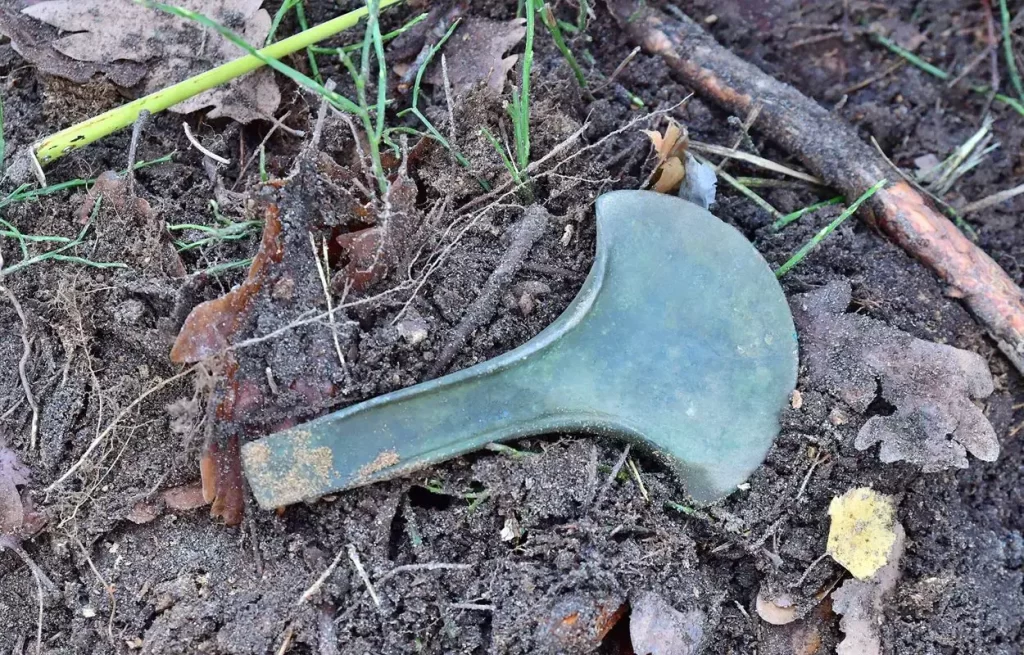Archaeologists in Poland have made an exceptional discovery in the Starogard Forest District, situated in the Kociewie region, where they unearthed five Bronze Age axes dating back thousands of years. The find was initially brought to the attention of authorities by a local history enthusiast, Denis Konkol, who adhered to Poland’s strict artifact discovery regulations. Under Polish law, it is illegal for amateurs to conduct metal detector searches for historical objects without proper authorization. Any discovered artifacts must be reported to the authorities and automatically become the property of the state, ensuring that valuable historical objects are preserved and studied in an official capacity.

Following the report, a team of archaeologists from the Pomeranian Provincial Conservator of Monuments, along with experts from the Provincial Office for the Protection of Monuments, arrived at the scene to inspect the site. Upon closer examination, they identified five well-preserved axes buried within a relatively small area. The artifacts were found at a depth of approximately 20 to 30 centimeters beneath the forest floor, carefully concealed under layers of turf and humus.
Igor Strzok, the Pomeranian provincial conservator of monuments, emphasized the significance of the controlled excavation, stating, “The extraction of these finds took place under the archaeological supervision of our colleagues from the Provincial Office for the Protection of Monuments. This means that we prevented possible destruction of the site.” His statement highlights the importance of professional oversight in such cases, ensuring that historical evidence remains intact and is properly documented for further research.
Preliminary analysis suggests that the five axes date from between 1700 and 1300 BC, placing them within the Bronze Age. Researchers believe that they were likely a ritual deposit, possibly linked to religious or cultic practices of the time. However, they have not ruled out the possibility that the axes may have also been deposited as part of a trade-related exchange. This dual interpretation underscores the complexity of such discoveries, as objects buried in the past often carry multiple layers of historical and cultural significance.
The axes themselves are classified as tautušiai-type weapons, a category associated with the ancient Baltic cultures, particularly those from present-day Lithuania and northeastern Poland. These axes are notable for their distinct design, characterized by a relatively large size, an elongated and slim handle with raised edges, and a broad, well-defined blade. Their craftsmanship suggests they were not just utilitarian tools but held ceremonial or symbolic importance.
The discovery is particularly remarkable given the region’s archaeological history. While Bronze Age sites in this part of Poland have yielded various artifacts over the years, such as bracelets and breastplates, the unearthing of a weapon or functional Bronze Age tool is far less common. In fact, this is the first such discovery in the region in the past two decades, underscoring the rarity and significance of these axes.
Archaeologists are now preparing the artifacts for transport to the Archaeological Museum in Gdańsk, where they will undergo a thorough examination. Specialists will analyze the composition of the metal, study the manufacturing techniques, and attempt to determine whether the axes were locally produced or imported from other regions. Such analyses provide crucial insights into the technological capabilities and trade networks of Bronze Age societies.
Additionally, experts will assess whether any organic residue or microscopic traces remain on the axes, which could offer clues about their usage. If remnants of wood, leather, or other materials are detected, it might indicate that the axes were once attached to handles or stored in protective coverings. These details help reconstruct how such tools were used in daily life or ritualistic ceremonies thousands of years ago.
This discovery not only adds to our understanding of Bronze Age cultures in the Baltic region but also raises questions about the societal and religious structures of the time. The deliberate burial of such objects suggests a cultural practice that extended beyond mere functionality. Many similar finds across Europe have been linked to offerings made to deities, burial rituals, or symbolic gestures marking important transitions in community life. The presence of these axes in a relatively concentrated area further supports the theory that they were intentionally placed as part of a meaningful act, rather than simply being lost or discarded.
Moreover, the discovery invites further exploration into the trade routes that existed during the Bronze Age. The design and material composition of the axes may reveal connections between different cultural groups, shedding light on the extent of interactions between early European societies. If analysis confirms that the metal used in these axes originated from a distant region, it could provide evidence of long-distance trade networks that spanned across what is now Poland, Lithuania, and beyond.
While the excavation of the site has been carefully managed, archaeologists may consider conducting further digs in the surrounding area to determine whether additional artifacts are buried nearby. In many cases, such deposits are part of larger ritual sites, where multiple objects are buried in clusters. If more objects are found, it could significantly enhance our understanding of how these axes fit into the broader cultural and historical landscape of the time.
For now, the five Bronze Age axes stand as a testament to the rich history hidden beneath Poland’s forests. Their discovery serves as a reminder of the importance of archaeological preservation and the role that careful excavation plays in uncovering the stories of the past. With further study, these artifacts may reveal even more about the lives, beliefs, and trade practices of the people who lived in the region over 3,000 years ago.
As experts continue their research, the findings will likely be shared with the public through exhibitions at the Archaeological Museum in Gdańsk, allowing visitors to appreciate these rare and ancient artifacts up close. Such discoveries not only enrich our understanding of the past but also highlight the ongoing efforts of archaeologists to piece together human history, one artifact at a time.





